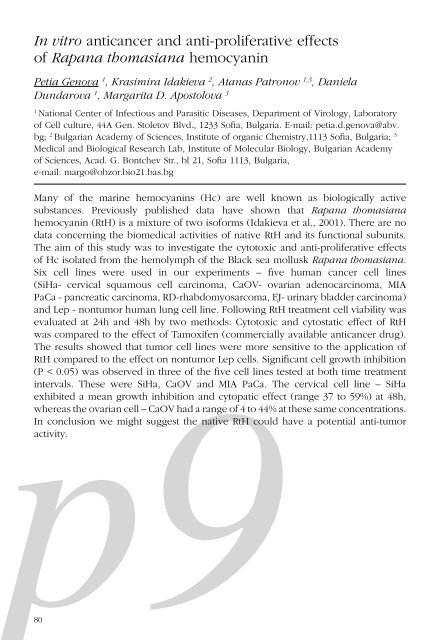Create successful ePaper yourself
Turn your PDF publications into a flip-book with our unique Google optimized e-Paper software.
In vitro anticancer and anti-proliferative effects<br />
of Rapana thomasiana hemocyanin<br />
Petia Genova 1 , Krasimira Idakieva 2 , Atanas Patronov 1,3 , Daniela<br />
Dundarova 1 , Margarita D. Apostolova 3<br />
1<br />
National Center of Infectious and Parasitic Diseases, Department of Virology, Laboratory<br />
of Cell culture, 44A Gen. Stoletov Blvd., 1233 Sofia, Bulgaria. E-mail: petia.d.genova@abv.<br />
bg; 2 Bulgarian Academy of Sciences, Institute of organic Chemistry,1113 Sofia, Bulgaria; 3<br />
Medical and Biological Research Lab, Institute of Molecular Biology, Bulgarian Academy<br />
of Sciences, Acad. G. Bontchev Str., bl 21, Sofia 1113, Bulgaria,<br />
e-mail: margo@obzor.bio21.bas.bg<br />
Many of the marine hemocyanins (Hc) are well known as biologically active<br />
substances. Previously published data have shown that Rapana thomasiana<br />
hemocyanin (RtH) is a mixture of two isoforms (Idakieva et al., 2001). There are no<br />
data concerning the biomedical activities of native RtH and its functional subunits.<br />
The aim of this study was to investigate the cytotoxic and anti-proliferative effects<br />
of Hc isolated from the hemolymph of the Black sea mollusk Rapana thomasiana.<br />
Six cell lines were used in our experiments – five human cancer cell lines<br />
(SiHa- cervical squamous cell carcinoma, CaOV- ovarian adenocarcinoma, MIA<br />
PaCa - pancreatic carcinoma, RD-rhabdomyosarcoma, EJ- urinary bladder carcinoma)<br />
and Lep - nontumor human lung cell line. Following RtH treatment cell viability was<br />
evaluated at 24h and 48h by two methods: Cytotoxic and cytostatic effect of RtH<br />
was compared to the effect of Tamoxifen (commercially available anticancer drug).<br />
The results showed that tumor cell lines were more sensitive to the application of<br />
RtH compared to the effect on nontumor Lep cells. Significant cell growth inhibition<br />
(P < 0.05) was observed in three of the five cell lines tested at both time treatment<br />
80p9<br />
intervals. These were SiHa, CaOV and MIA PaCa. The cervical cell line – SiHa<br />
exhibited a mean growth inhibition and cytopatic effect (range 37 to 59%) at 48h,<br />
whereas the ovarian cell – CaOV had a range of 4 to 44% at these same concentrations.<br />
In conclusion we might suggest the native RtH could have a potential anti-tumor<br />
activity.
















